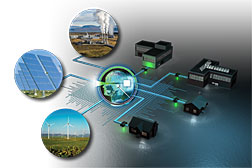- Number 383 |
- March 4, 2013
Engineering grid resilience

Systems controlling utilities and factories
can be engineered to resist interruption
from natural or man-made disasters.
Hurricane Sandy illustrated the need to build resilience into complex systems that provide energy, water and emergency response at levels considered luxurious just a generation ago. DOE's Idaho National Laboratory has pioneered thinking about "resilient" systems that are more resistant to interruption from natural or man-made disasters.
The modern industrial plant control system is made up of numerous networked computer components, switches and valves that perform certain "smart" functions to control systems and operate processes. The interconnected parts, nodes and links collectively exhibit emergent properties or behaviors beyond those of individual components.
Complexity in a system arises when component interdependencies supersede the function of individual components. These interdependencies can cause system rigidity or brittleness, which can lead to system failure when single elements are compromised. The key problem is predicting, characterizing and resolving the component interactions in such a way that they cannot become common sources of failure.
INL has pioneered work to improve control system resilience. The lab's Instrumentation, Control and Intelligent Systems distinctive signature has described two general ways that resilient systems cope with failure and attack. Adaptive systems include intelligent components designed to function in more than one role, leading to emergent properties that counterbalance anomalies. Transformable systems utilize diversity to reconstitute into fundamentally new systems when external forces render an existing system indefensible.
Inherently resilient systems also can help guard against hackers. If security — layered "electronic gatekeepers" combined with security professionals — is defeated, co-opted computers become the soft underbelly of control systems. A resilient control system would integrate diverse cyber and physical protections and impart benefits from inherent redundancy by selecting accurate, relevant sensor readings for basing decisions or performing feedback control.
Truly resilient systems intelligently route around broken system components to avoid cascading failures. They also draw on reserve resources and focus human attention on the problems machines either can't or shouldn't solve alone. The development of such technologies will underpin next-generation designs for critical infrastructure.Submitted by DOE’s Idaho National Laboratory
